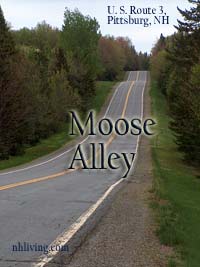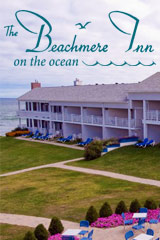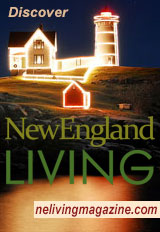NH Moose Viewing
NH Moose Tours, Photographs & Information
 Also known as Eurasian Elk, the North American Moose is the largest species in the deer family, and most often found in the northernmost regions of America and throughout Alaska and Canada. Due to their sheer size, the only predators that affect the moose population are humans, bears and wolves. Moose are loners and don’t normally travel in packs or herds, and are known to become aggressive, particularly when surprised or during rutting season. Ask us about planning your NH vacation or relocation. To feature your business, contact us.
Also known as Eurasian Elk, the North American Moose is the largest species in the deer family, and most often found in the northernmost regions of America and throughout Alaska and Canada. Due to their sheer size, the only predators that affect the moose population are humans, bears and wolves. Moose are loners and don’t normally travel in packs or herds, and are known to become aggressive, particularly when surprised or during rutting season. Ask us about planning your NH vacation or relocation. To feature your business, contact us.
Seeing Moose In New Hampshire
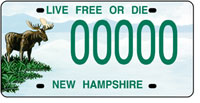 The moose is an often loved and photographed animal and here in New Hampshire the moose is also a tourist attraction, food source, prey for hunters, and symbol of New Hampshire’s wild North Country. New Hampshire has a State Park and Summer Festival named after this docile animal and New Hampshire motorists can demonstrate their affection of this mammal by purchasing a special edition Moose license plate.
The moose is an often loved and photographed animal and here in New Hampshire the moose is also a tourist attraction, food source, prey for hunters, and symbol of New Hampshire’s wild North Country. New Hampshire has a State Park and Summer Festival named after this docile animal and New Hampshire motorists can demonstrate their affection of this mammal by purchasing a special edition Moose license plate.
Moose in New Hampshire, however can be quite dangerous – moose and vehicle collisions are on the rise and claim several lives every year. The dark fur make moose very had to detect, especially at night. While most moose stay in the higher elevations in the deep woods, some wander into roads, backyards, and highways in search of a mate or a salt-laced bog by the side of the road. Moose love mud and are often spotted just off the side of the road standing in mud.
An adult moose, averages 1000 pounds and stands 6 feet at the shoulder. The moose is the largest wild animal in North America. Moose have keen senses of smell and hearing, but they’re also near-sighted.
Moose is an Algonquin (native American) term for “eater of twigs.” Moose are browsers feeding on leaves, twigs, and buds of hardwood and softwood trees and shrubs. A healthy moose consume 40-60 pounds of leafage daily. Moose favor willows, birches, aspens, maples, fir, and viburnums. In the fall they begin feeding on the bark of some hardwoods, particularly maples and aspens. In the winter moose feed on the buds and new woody growth of these plants. Moose feed heavily on sodium-rich aquatic plants in summer.
Cows (female moose) prefer to keep their calves near water as an escape route for their calves. Ponds are used by both sexes to escape from moose flies and other pesky insects. Moose wallows form in wet areas on the sides of highways where road salt accumulates. Moose visit these areas to drink the salty water thereby satisfying their salt requirements. Bull moose create wallows by pawing out depressions then urinating in them. Bulls and cows will roll in the wallow during the breeding season.
WHERE TO SEE MOOSE
Moose are have been spotted in nearly every corner of New Hampshire and the moose herd is growing. The vast majority of the states moose reside “north of the notch” – that is the area north of the White Mountains. Pittsburg, New Hampshire is known as New Hampshire Moose Capital and is where you’ll find “Moose Alley” – the far northern section of U.S. Route 3 from Pittsburg to the Canadian border. Many moose live in this region and the moose here have become celebrities of sorts, attracting thousand of tourists a year intent on catching a glimpse of North America’s largest land animal. Route 26 near Colebrook is a nationally recognized “watchable wildlife corridor” with designated viewing stations for moose and peregrine falcons in Dixville Notch.
WHEN TO SEE MOOSE
Moose are most active in the early morning and early evening hours. Just before sunset moose will roam in search of saplings or salt. Moose are vegetarians and often seek out the young saplings.
PHOTOGRAPHING MOOSE
If you do see moose, use a zoom or telephoto lens to bring the creature up-close. Do not try to walk up to a moose. The animals are skiddish and may dart into the road or right at you or your vehicle. An adult moose can easily cause thousands of dollars in damage to your vehicle – even if your vehicle is stationary when it meets up with a moose.
BRAKING FOR MOOSE
The signs on New Hampshire highways urge you to brake for moose. It is wise to heed this advise if you spot a moose while driving. Moose have been known to be “spooked” easily and dart into the roadway. Moose are not particularly bright and are not afraid of cars, motorcycles or trucks. Braking for moose means just that – STOP! Then proceed very slowly until the moose is out of sight. Many a moose collision has occurred after the vehicle slowed down but failed to stop. Some 200 moose are killed on New Hampshire roads every year.
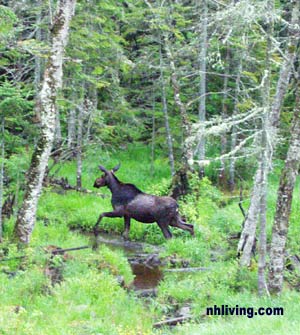
A Moose Crosses a Stream in Pittsburg, NH
Also Visit NH Attractions | NH Events
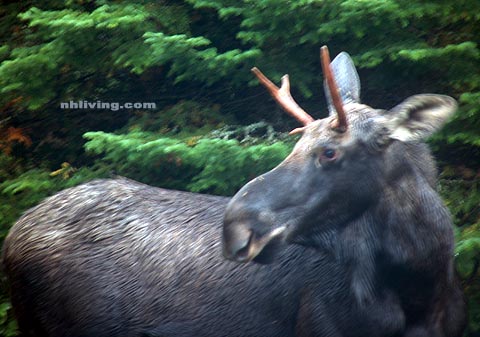
This handsome young moose was photographed near Pittsburg New Hampshire. | NHLiving.com
NH Lodging Guide | Weddings
Products | NH Town Guides
New England Living Magazine
Free World Mall
Country Weddings | New England Recipes
Paradise Coast Living | Boston Red Sox Gifts
Vermont Living | ME Living | MA Living

